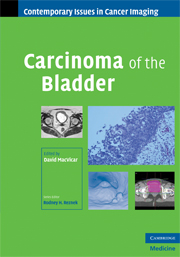Book contents
- Frontmatter
- Contents
- Contributors
- Series foreword
- Preface to Carcinoma of the Bladder
- 1 The pathology of bladder cancer
- 2 Clinical features of bladder cancer
- 3 Imaging in the diagnosis of bladder cancer
- 4 Radiological staging of primary bladder cancer
- 5 Imaging of metastatic bladder cancer
- 6 Surgery for bladder cancer
- 7 External beam radiotherapy for the treatment of muscle invasive bladder cancer
- 8 The chemotherapeutic management of bladder cancer
- 9 Clinical follow-up of bladder cancer
- 10 Imaging of treated bladder cancer
- Index
- Plate section
- References
8 - The chemotherapeutic management of bladder cancer
Published online by Cambridge University Press: 25 August 2009
- Frontmatter
- Contents
- Contributors
- Series foreword
- Preface to Carcinoma of the Bladder
- 1 The pathology of bladder cancer
- 2 Clinical features of bladder cancer
- 3 Imaging in the diagnosis of bladder cancer
- 4 Radiological staging of primary bladder cancer
- 5 Imaging of metastatic bladder cancer
- 6 Surgery for bladder cancer
- 7 External beam radiotherapy for the treatment of muscle invasive bladder cancer
- 8 The chemotherapeutic management of bladder cancer
- 9 Clinical follow-up of bladder cancer
- 10 Imaging of treated bladder cancer
- Index
- Plate section
- References
Summary
sIntroduction
Approximately 20% of patients diagnosed with bladder cancer have muscle invasion at the time of presentation, and up to 50% of these patients will develop metastatic disease after successful local treatment. Bladder cancer is a relatively chemosensitive disease, with objective response rates of up to 25% with single agent chemotherapy and response rates of up to 50% with combination chemotherapy. The most commonly used regimens have historically been those combining cisplatin, methotrexate, vinca alkaloids and doxorubicin. In more recent years, the development of newer agents has led trials examining the role of gemcitabine and docetaxel as first- and second-line treatment for advanced bladder cancer. Care must be taken in delivering chemotherapy to patients with significant renal impairment as cisplatin is renally toxic, and methotrexate is excreted via the kidneys. In patients with renal insufficiency, carboplatin can be substituted for cisplatin and plasma methotrexate levels should be monitored and folinic acid rescue employed to prevent life-threatening toxicity.
Chemotherapy for bladder cancer is used in the neoadjuvant and adjuvant setting in combination with radical local treatment (cystectomy or radiotherapy) or for palliation in patients with advanced disease. Concurrent chemotherapy with radiotherapy has also been given with the aim of improving the therapeutic ratio of radical radiotherapy.Table 8.1 describes the scheduling of the chemotherapy regimens commonly used for the management of bladder cancer.
Neoadjuvant chemotherapy
Neoadjuvant chemotherapy has two potential therapeutic benefits: to improve the likelihood of bladder preservation and to eradicate micrometastatic disease.
- Type
- Chapter
- Information
- Carcinoma of the Bladder , pp. 125 - 136Publisher: Cambridge University PressPrint publication year: 2008

